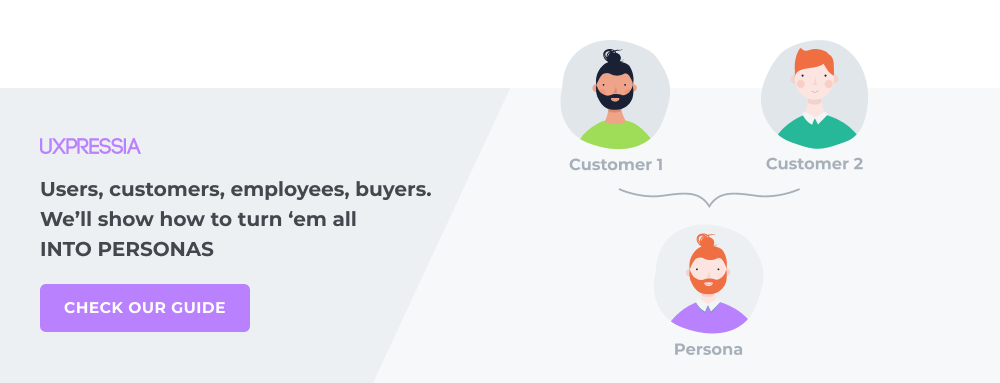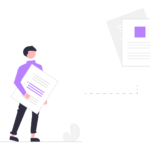Creating a buyer persona is a crucial step in understanding your target audience and tailoring your business strategies for maximum impact. But where do you start?
In this ultimate guide, we’ll walk you through everything you need to know about buyer personas—from understanding what they are and exploring different types to step-by-step instructions on how to build one. We’ll also discuss the tangible benefits they bring to your marketing, sales, and product strategies.
We’ll also share real-world examples to inspire you and help bring your own personas to life. Whether you’re new to this concept or looking to refine your persona creation approach, this guide will equip you with the tools to create buyer personas that drive actual results.
Ready to dive in? Let’s get started!
Contents
What is a buyer persona? (and why you need one)

A buyer persona is a semi-fictional representation of your ideal customer based on real data, market research, and insights about your existing clients.
Buyer persona creation is not just about putting a human face on your customer base; it's about understanding the underlying motivations, challenges, and goals that drive their decisions.
When you define a buyer persona, you get a powerful tool that informs every aspect of your business strategy. This insight is invaluable in ensuring that your product or service truly meets the needs of your target audience.
In the B2C realm, a B2C buyer persona helps you connect with consumers on a more personal level. Understanding their preferences, shopping habits, and pain points allows you to craft compelling messages that resonate with them, ultimately driving engagement and loyalty.
For B2B companies, a well-crafted B2B buyer persona helps understand the decision-making process within organizations, allowing you, for example, to tailor your approach to different stakeholders. Whether you're dealing with a CEO focused on ROI or a tech manager concerned with integration, a B2B buyer persona ensures your messaging hits the mark.
Here are some examples of how buyer personas can be used across your business:
- When it comes to marketing, buyer personas are essential. They help you craft targeted campaigns, choose the right channels, and design ads that resonate with your audience, ensuring your efforts are both effective and efficient. By aligning your strategies with persona insights, you can maximize ROI and build stronger customer connections.
- Beyond sales, buyer personas are vital for product development. They enable teams to prioritize features and solutions that truly matter to your audience, leading to products that are both innovative and aligned with market needs.
- For customer success teams, buyer personas provide a clear understanding of the customer journey and common challenges, allowing them to proactively address issues and enhance the overall experience.
In short, buyer personas influence every aspect of your business—from product development to customer retention—ensuring your strategies are well-targeted and effective in the long run.
Types of buyer personas
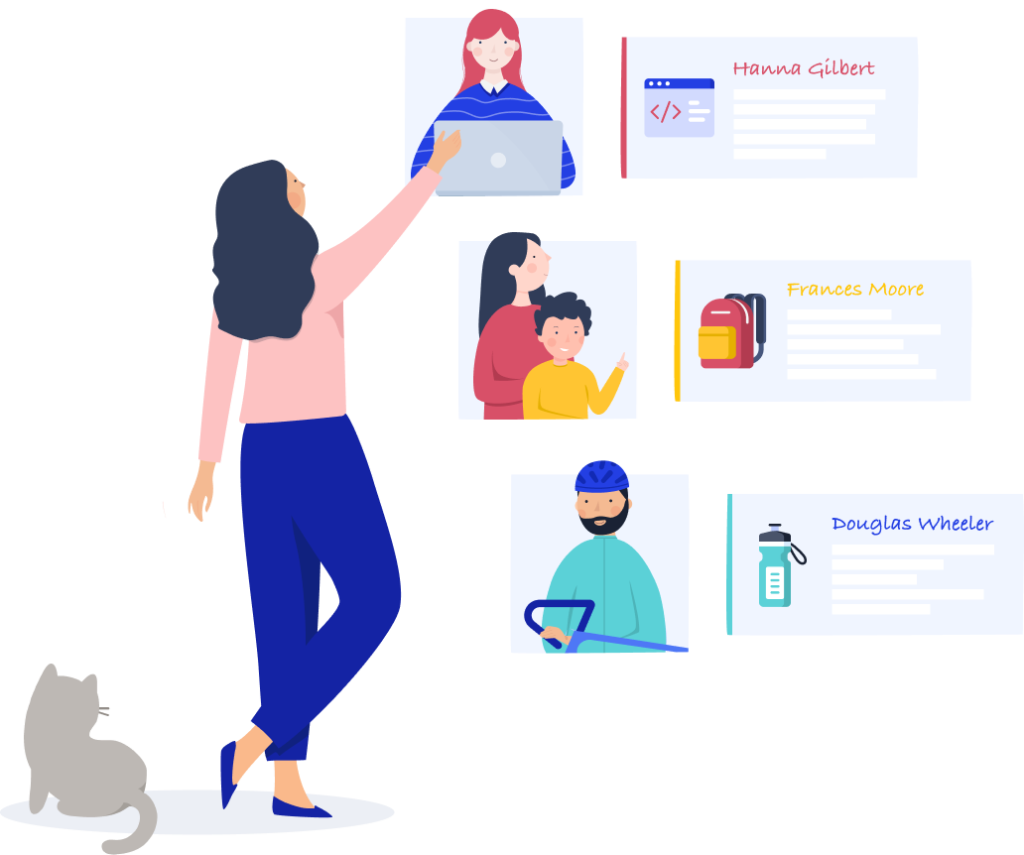
There are different ways to categorize buyer personas, depending on your business focus and goals.
By domain
In this case, it’s important to recognize that different types of businesses and their target audiences may require different approaches. Whether you’re focusing on B2B, B2C, or B2BC, each domain shares similar characteristics and challenges, but the scale and specifics can vary, influencing how personas are developed and utilized.
Understanding these differences allows you to tailor your promotion, sales, and product strategies more effectively to meet the specific needs of each type of buyer. Here’s a closer look at each domain and how buyer personas can be crafted to align with their unique dynamics:
- A B2B buyer persona represents a business or specific role within an organization, such as a decision-maker, influencer, or end-user. This type of persona focuses on the professional goals, challenges, and motivations that drive business purchasing decisions.
For example, a B2B buyer persona might be "Operations Olivia," a Supply Chain Manager in a manufacturing company who is focused on efficiency and cost reduction. Olivia is concerned with finding suppliers that offer reliable delivery times and competitive pricing.
- A B2C buyer persona covers individual consumers who make purchasing decisions based on personal needs, preferences, and emotions. These personas are essential for companies that sell directly to consumers.
For instance, "Fitness Fiona" could be a B2C buyer persona representing young fitness enthusiasts who value health and wellness products. Fiona is likely to respond well to messages that highlight the benefits of organic ingredients, convenience, and brand transparency. Creating a buyer persona profile like Fiona’s helps businesses tailor their messaging to resonate with her lifestyle and purchasing behavior.
- A B2BC buyer persona is used in scenarios where a business sells to another business, which in turn serves the end consumer. This type of persona needs to consider both the business partner's goals and the expectations of the final consumer.
For example, "Retail Ron," a Purchasing Manager for a retail chain, is focused on sourcing products that appeal to his customers while maintaining good supplier relationships. In this case, your strategies could benefit from addressing both Ron’s need for high-quality, sellable goods and the end consumer's desire for trendy, affordable products.
By behavior
Behavioral personas are classified based on how individuals or companies approach their purchasing decisions. These personas are useful in understanding the customer journey and tailoring your business strategies accordingly.
Here are a few examples of such persona types:
- Researcher

AI-generated picture
This buyer persona profile would be someone methodical and detail-oriented. They spend significant time researching products, reading reviews, and comparing options before making a decision.
For example, "Analytical Alex," a CMO at a tech firm, might be a B2B buyer persona who thoroughly evaluates software solutions before choosing one. Marketing to Alex would involve providing in-depth whitepapers, case studies, and detailed product comparisons to satisfy his need for comprehensive information.
- Impulse buyer

In contrast, an Impulse buyer persona makes quick decisions, often driven by emotions or immediate needs.
For example, "Spontaneous Sarah" could be a B2C buyer persona drawn to limited-time offers or flash sales. Sarah responds well to your tactics that create a sense of urgency, such as countdown timers, exclusive discounts, or highly visual ads that capture her attention quickly.
- Loyalist

A Loyalist persona is characterized by strong brand loyalty and a preference for consistency.
For instance, "Brand-Devoted Brian," a long-time customer of a specific automotive brand, continues to purchase from the same company because he values reliability and familiarity. Strategies for Brian might focus on maintaining a strong brand narrative, emphasizing customer satisfaction, and offering rewards programs that reinforce his loyalty.
By demographics
Demographic personas are based on specific characteristics such as age, gender, income level, education, and geographic location. These personas are crucial in segmenting your market and targeting specific audience groups with tailored messaging.
We listed a few examples, yet there can be more depending on your criteria:
- Young professional

This persona might be a B2C buyer persona like "Urban Emma," a 30-year-old manager living in a big city.
Emma is career-driven, values convenience, and is tech-savvy. She prefers products that enhance her lifestyle, such as meal delivery services or smart home devices. Buyer persona creation for Emma would involve highlighting how your product saves time, integrates with other tech, or aligns with her fast-paced urban lifestyle.
- Family-oriented consumer

"Family-Focused Frank," a 40-year-old father of two, represents a persona that values safety, practicality, and cost-effectiveness.
As a B2C buyer persona, Frank will likely prioritize products that benefit his family, such as home security systems, family vehicles, or educational toys. Business strategies for Frank should emphasize product safety, family benefits, and long-term value.
- Retiree

A persona like "Retired Rita," a 65-year-old who values comfort, ease of use, and affordability, falls under the demographic classification. Rita may be less interested in the latest trends but is drawn to simple and reliable products. For companies targeting this segment, creating advertising messages highlighting ease of use, support services, and peace of mind is important.
These examples show a few possibilities, but you can combine different criteria or even develop entirely new personas based on your business needs and audience insights.
How to build a buyer persona
Building a buyer persona involves a process that will vary depending on your business model, whether you're in B2C or B2B. While including some details in a buyer persona is always important, others will change based on your business goals and the specific needs of your audience.
Let’s explore how to build a buyer persona through two illustrative examples, highlighting the differences between B2C and B2B approaches.
Building a B2C buyer persona
Imagine you run an e-commerce business that sells organic skincare products. You aim to create a B2C buyer persona that will guide your efforts.
- Demographics: For a B2C persona, the demographic section is oftentimes crucial. You might include age, gender, income level, education, and location. For example, your buyer persona, "Eco-Conscious Emma," might be a 28-year-old woman living in a metropolitan area with a medium-to-high income and a strong interest in sustainability.
- Behavioral insights: Understanding Emma’s shopping habits is key. Perhaps she frequently searches for cruelty-free products and reads online reviews before making a purchase. These insights help tailor your messages to highlight these values and address key moments of truth, such as when Emma is deciding between products or questioning their authenticity.
- Pain points and solutions: Emma might be concerned about finding genuinely eco-friendly products that deliver results. In this section, note her pain points and how your products solve them. This could guide the creation of content for landing pages or social media ads, emphasizing your skincare line's effectiveness and ethical production.
- Keywords and content hooks: Here, you’d identify the search terms Emma might use, such as "best organic face cream" or "cruelty-free skincare." These keywords are essential for SEO and paid search campaigns. Additionally, you might create messaging that speaks directly to Emma’s concerns, such as, "Tired of false green claims? Our certified organic products deliver real results."
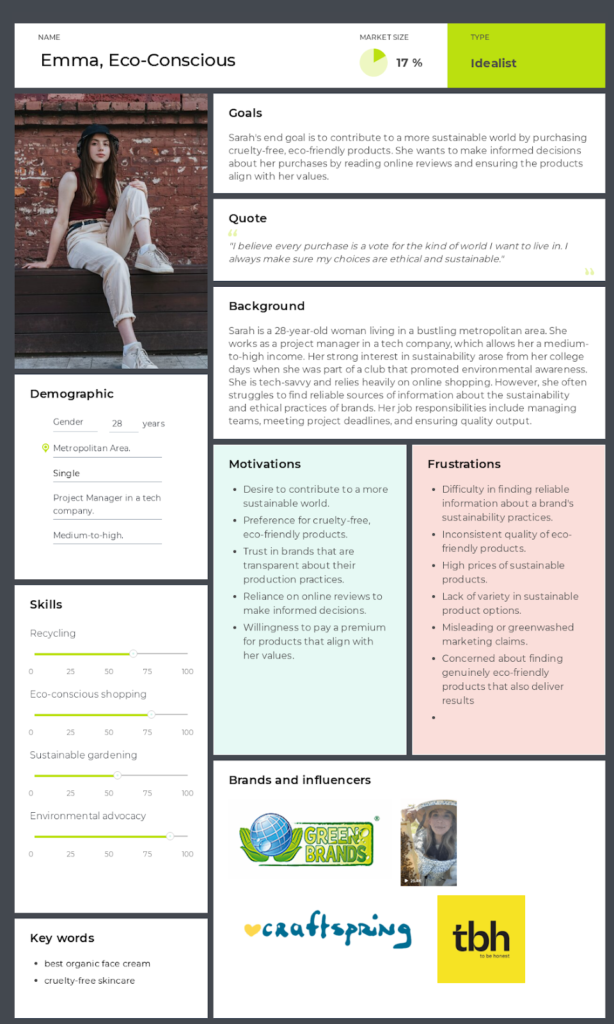
In this B2C case, demographics and personal shopping behavior are critical sections. They help you connect with Emma personally, making your sales efforts more targeted and effective.
Building a B2B buyer persona
Now, let’s switch to a B2B context. Imagine you want to dive into a buyer journey for a SaaS company that provides project management software to medium-sized businesses. You aim to create a B2B buyer persona to guide your sales and product development efforts.
- Company information: Unlike B2C, where individual demographics are crucial, B2B personas often focus on company-specific details. For instance, your persona, "Operations Olivia," might represent a project manager at a company with 100–500 employees working in the tech industry. Understanding the company’s size, industry, and pain points is key.
- Budget and average deal size: For a B2B persona, knowing the company’s budget or average deal size is vital. Olivia’s company might typically spend $10,000 per year on software solutions. This information helps you tailor your pricing strategy and sales pitches.
- Decision-making process: Unlike B2C, where decisions are often made individually, B2B purchasing usually involves multiple stakeholders. You’d need to map out Olivia’s role in the decision-making process and identify other influencers, such as the IT manager or CFO. This helps in crafting targeted messaging for each stakeholder involved.
- Pain points and solutions: Olivia might be struggling with coordinating multiple teams and projects efficiently. In this section, outline how your software addresses these pain points, perhaps by offering integrated tools that streamline collaboration. This information can be used to develop case studies or whitepapers that resonate with her needs.
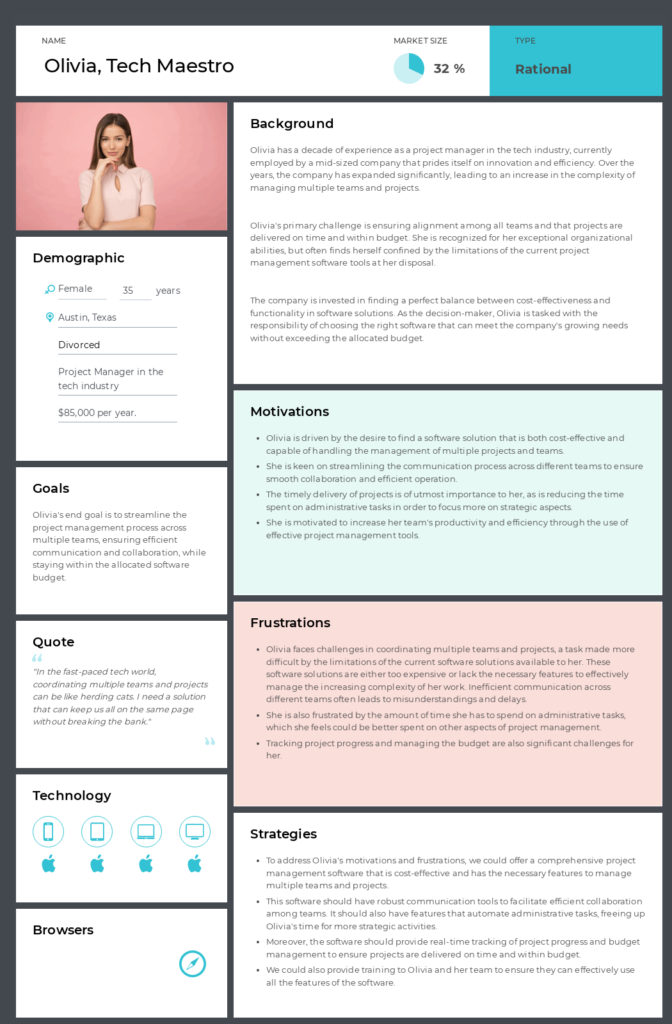
In this B2B case, demographic information might be less relevant, while company details, budget considerations, and the decision-making process are critical. These sections ensure that your product and sales strategies align with the specific needs and structure of the target business.
What else to include in a buyer persona profile?
Chances are, when building a buyer persona for a B2C or B2B domain, your final outputs will share some common elements. These typically include sections like pain points, solutions, and key messaging hooks. However, the specifics of these sections—and whether you need additional ones—will ultimately depend on your goals and the unique needs of your business.
What to ask yourself when creating a persona
Below are some questions to help you make sure that your persona profile feels real and reflects the actual clientele:
- Did you choose an authentic name that evokes empathy and makes stakeholders believe this persona is real?
- Is the photo you picked realistic and shows the appropriate context?
- Do you focus on the demographics that impact your product service?
- Does the background give your persona a story and tie all the details together?
- What is the end goal of your persona? Goals are actually why customers "hire" your product.
- Does the motivation you found lead to your product or service enhancements?
- What frustrations can you eliminate to make customers feel safer and more likely to return?
- People have certain expectations when they come to you, even if they don't know what to expect. Do you know the expectations to help you tailor your approach and convert customers faster?
- What are your customers' challenges, and how can you help to overcome those challenges?
- How skilled are your customers in a certain field? This will highlight the differences between your personas and guide you toward optimal solutions.
- Do you capture what customers say about your service? Nothing beats the real voice of your customer.
- Are you describing detailed and low-level requests and wishes related to completing particular tasks? These are complementary to user goals.
- What are the past experiences of your persona? Can they help you understand how customers interact with your product and what experiences should be avoided?
The most important takeaway from building a buyer persona is to keep your goals in mind. The sections you include should directly support your business objectives, whether improving your promotional campaigns, refining your sales strategy, or guiding product development.
Buyer persona examples
When creating effective buyer personas, real-world examples can provide valuable insights. Below are examples tailored to different business scenarios from the UXPressia template library:
- Buyer persona: High-tech business
"Tech Visionary" is a company seeking to enhance its presence in the media through strategic PR services. This persona represents a forward-thinking business looking to partner with another company to manage and execute its public relations strategy, ensuring its brand is effectively communicated and recognized in the industry.
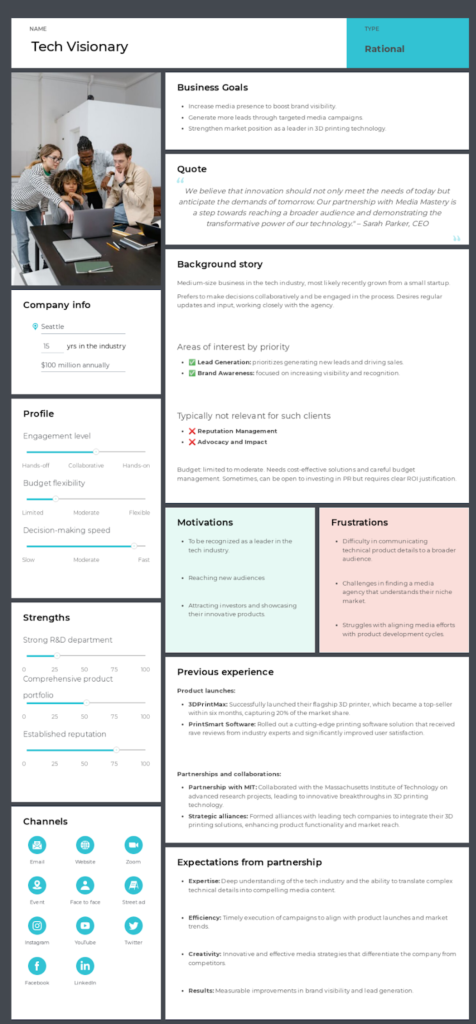
- Buyer persona: SaaS business
The second persona is searching for an online product that will improve their company's operations. They are looking for a solution that can streamline processes and boost efficiency. Their main goal is to find a tool that aligns with the company’s needs and delivers tangible results.
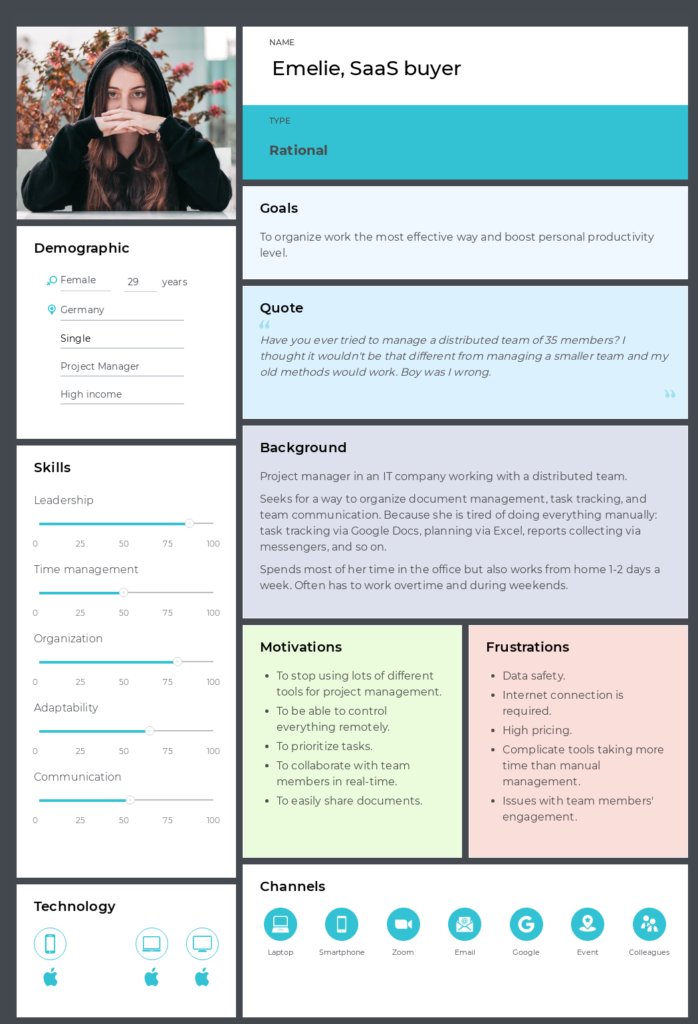
- Buyer persona: Car-sharing business
The buyer persona is tailored for a car-sharing business. It focuses on understanding the needs and behaviors of potential users who prefer flexible and affordable transportation options. This persona helps in creating targeted strategies to attract and retain customers in the car-sharing market.
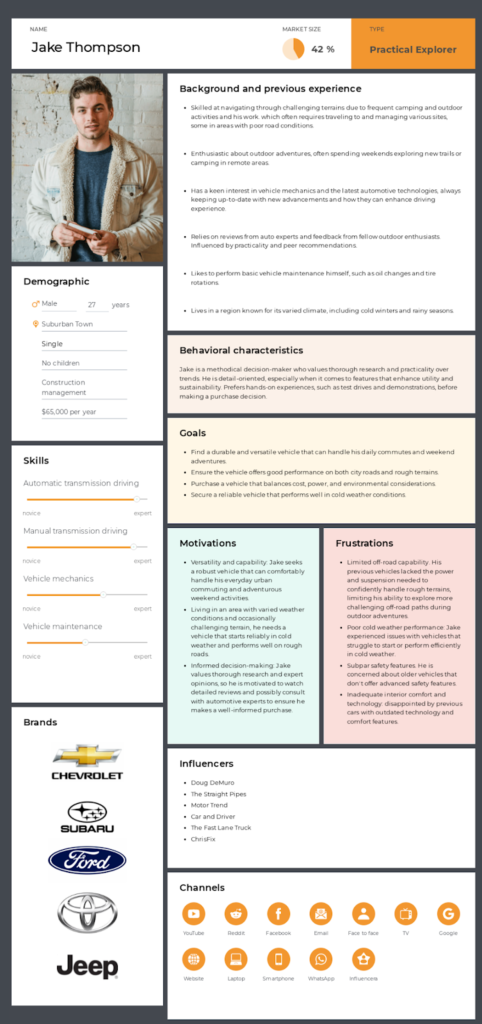
Wrapping up
Developing a buyer persona is crucial for shaping a business strategy that truly connects with your target audience. Whether you're in a B2B or B2C market, gaining insights into your customers' needs, challenges, and goals enables you to customize your product offerings, marketing tactics, and sales approaches for optimal results.
The key point to remember:
Tailor your approach. The sections you include in your buyer persona should directly reflect the goals of your business. For B2B personas, focus on company details, budget, and decision-making processes. For B2C personas, demographics, and personal shopping behaviors are crucial.
By following the steps outlined in this guide and utilizing the ready-to-go templates provided, you’ll be well on your way to creating buyer personas that inform your strategy and drive meaningful results for your business. Now, it’s time to put these insights into action and connect with your customers on a deeper level.
